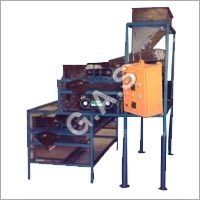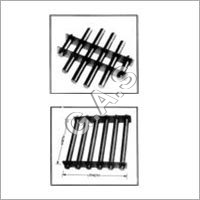Magnetic Roll Separators
Magnetic Roll Separators Specification
- Surface Finish
- Polished
- Frequency
- 50/60 Hz
- Magnet Grade
- N52
- Material
- Stainless Steel, Rare Earth Magnets
- Composite
- Stainless Steel & Rare Earth Magnets
- Power Supply
- Electric
- Product Type
- Magnetic Roll Separator
- Magnet Category
- Permanent Magnet
- Magnet Type
- Neodymium Iron Boron (NdFeB)
- Shape
- Cylindrical Roll
- Size Range
- 300 mm to 1500 mm roll diameter
- Color
- Blue/Silver
- Usage & Applications
- Separation of fine, dry materials, minerals, pharmaceutical powders
- Capacity
- Up to 10 TPH
Magnetic Roll Separators Trade Information
- Minimum Order Quantity
- 1 Piece
- Supply Ability
- 10 Pieces Per Month
- Delivery Time
- 1 Week
About Magnetic Roll Separators
In our extensive gamut of products, we bring forth for our clients Magnetic Roll Separators. These roll separators are used to remove ferromagnetic to weakly paramagnetic fine iron contaminations from the products such as Silica sand, quartz, magnesite, feldspar, dolomite, food products, chemicals, ceramics, etc. Offered machines are fabricated using high-energy rare earth neodymium permanent magnets that are assembled in a proprietary configuration to generate forces of magnetic attraction. Clients can avail a wide variety of offered Magnetic Roll Separators at industry leading price.
Features:
- Robust construction
- Reliable operation
- Less maintenance
- Long service life
Superior Separation Performance
Harnessing high-grade N52 Neodymium Iron Boron magnets within a durable stainless steel frame, these separators capture fine, dry particles efficiently. Variable speed motorised drives and digital panels provide precise control for different materials, making the separator exceptionally adaptable to diverse needs.
Versatile Applications & Easy Integration
Widely used across mineral processing, pharmaceutical, and other fine powder industries, Magnetic Roll Separators can be customized in size and roll number to match your operation. Their floor-mounted design ensures stable installation and straightforward integration into both new and existing production lines.
Reliable, Low-Maintenance Operation
Built with polished stainless steel and robust rare earth magnets, these separators require minimal maintenance while ensuring longevity. The digital control panel, adjustable chute, and motorised functionality reduce downtime. Insulation Class F and low noise levels (<72 dB) offer added operational comfort and efficiency.
FAQs of Magnetic Roll Separators:
Q: How does the Magnetic Roll Separator achieve high-efficiency separation of fine dry materials?
A: Magnetic Roll Separators use powerful Neodymium Iron Boron (NdFeB) magnets with a polished stainless steel roll operating at speeds up to 1000 rpm. The magnetic forces capture fine and dry particles (up to 1 mm), effectively separating them from non-magnetic material as they pass over the cylindrical roll.Q: What industries can benefit from using Magnetic Roll Separators?
A: Industries such as mineral processing, pharmaceuticals, chemicals, and any sector dealing with fine, dry particulate materials benefit from these separators. They are especially useful for separating minerals or powders where purity and precise sorting are crucial.Q: When should I choose a single roll versus a multiple roll separator?
A: Single roll separators are suitable for lower capacity requirements or straightforward applications, while multiple roll configurations are ideal for higher throughput or more complex separation tasks, offering increased efficiency and higher purity in the final product.Q: Where should Magnetic Roll Separators be installed within an industrial process?
A: These separators are floor-mounted and can be integrated at points where dry material needs cleaning or grade improvement. They are best placed after primary processing to ensure only fine, non-magnetic materials continue down the production line.Q: What is the operating process for the separator and how is it controlled?
A: Material enters via a stainless steel feed hopper and is passed over the high-speed magnetic roll. The embedded magnets attract and separate magnetic particles, while non-magnetic material is discharged through an adjustable chute. Digital control panels allow for easy adjustment of roll speed and overall operation.Q: How does the use of Neodymium Iron Boron magnets benefit the separation process?
A: NdFeB magnets are the strongest type of permanent magnets available, classified as N52 grade. Their exceptional magnetic power ensures even ultra-fine materials (up to 1 mm) can be effectively separated, leading to higher product purity and recovery rates.Q: What are the noise and power requirements for operating the separator?
A: These separators operate at a noise level below 72 dB, ensuring a quieter workplace. They run on standard electric power with 50/60 Hz frequency, requiring minimal additional infrastructure for installation or operation.

Price:
- 50
- 100
- 200
- 250
- 500
- 1000+
More Products in Magnetic Equipments Category
Magnetic Filters
Price 10000 INR
Minimum Order Quantity : 1 Piece
Size Range : Custom as per requirement
Shape : Other, Cylindrical (Cartridge Form)
Surface Finish : Polished/Matte Finish
Product Type : Other, Magnetic Filter
Hump Magnetic Separators
Price 20000 INR / Piece
Minimum Order Quantity : 1 Piece
Size Range : 150 mm to 450 mm (Diameter)
Shape : Other, Hump (Angular) Construction
Surface Finish : Polished / Matt
Product Type : Other, Industrial Magnetic Separator
Magnetic Pulleys
Price 100000 INR
Minimum Order Quantity : 1 Piece
Size Range : Diameter: 150 mm to 1200 mm, Length: 300 mm to 2000 mm
Shape : Other, Cylindrical
Surface Finish : Painted and polished
Product Type : Other, Magnetic Pulley
Permanent Plate Magnets
Price 10000 INR
Minimum Order Quantity : 1 Piece
Size Range : 300 mm x 300 mm up to 1200 mm x 1200 mm (custom sizes available)
Shape : Other, Rectangular Plate
Surface Finish : Polished or powder coated
Product Type : Other, Plate Magnet

 Send Inquiry
Send Inquiry






 Send Inquiry
Send Inquiry Send SMS
Send SMS Call Me Free
Call Me Free